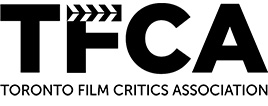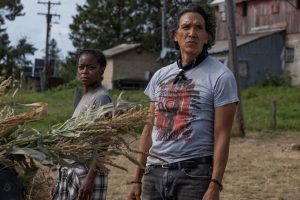Reviews include 40 Acres, Jurassic World: Rebirth, and Sorry, Baby.
Festival Diary: The 19th R.I.D.M.
November 18, 2016
By Adam Cook, guest contributor
One of the most adventurous and eclectic documentary film festivals in North America.
In some ways, RIDM — or, Rencontres internationales du documentaire de Montreal (Montreal International Documentary Festival) — is the last stop on the circuit, collecting the best works to have screened over the past year at True/False, Hot Docs, and TIFF. With 128 films in its 2016 edition, it’s a programme of considerable scope, but one of distinct curatorial quality. There’s a leaning towards the experimental and unconventional forms that characterize works of docu-fiction you might find in Wavelengths at TIFF rather than the standard doc section. Those who like their documentaries to be “cinematic”— in other words: formally interesting, and less in the didactic info-doc strand — are spoiled over the course of 11 days in Montreal.

Among the selection are works from established Canadian filmmakers, such as Alanis Obomsawin, who brings one of her finest (and unexpectedly Wiseman-esque) with We Can’t Make the Same Mistake Twice; acclaimed auteurs like Wang Bing whose staggering Ta’ang makes a great companion piece to his 2012 masterpiece Three Sisters; and obscure off-the-beaten-path choices like John Gianvito’s expansive 277-minute Wake (Subic), which further explores the damage done by America’s colonial presence in the Philippines he examined in 2010’s equally essential Vapor Trail (Clark). There’s also a focus on animation, films for children, installation work, and… yes, VR.
But the emphasis at RIDM is not so solely fixed on the seventh art. There are free musical acts most every night at the fest’s headquarters, which becomes a bar-like hangout for the public after dark, and the very scheduling of films encourages moviegoers to get their party on. The first film of the day typically isn’t until well into the afternoon (although some panel discussions and the like occasionally feature earlier). RIDM respects hangovers. It makes for a leisurely atmosphere, and without the premiere status garnered at other festivals, it’s an altogether low-key affair. As an attending critic, or an insatiable cinephile, it can actually be frustrating. On a good day, if you’re lucky, you can make it to three films, but that usually entails some good planning and tight windows on making it from one venue to the next. If you’re used to devouring dozens of films over the course of a few days, you’ll need to scale back your expectations on your volume of intake at RIDM. Fortunately, the programming is so strong that you’re unlikely to strike out on any given viewing choice, and while you may only see a handful of films, they’re going to be ones that stick with you, particularly as they won’t be drowned out in the over-consumptive gluttony that a festival veteran may be so accustomed.
Benjamin R. Taylor’s superbly curated screening series of experimental films in Montreal under the banner of “Visions” has its own space in the festival, which made for RIDM’s foremost highlight: a three-screening abbreviated retrospective of the work of Deborah Stratman. Active since the early 1990s, the Chicago-based artist was on hand to offer insights into work spanning over the past twenty years, including her latest, The Illinois Parables, shot on 16mm and divided into 11 disparate stories spanning Illinois’s history.

At first glance, they may not seem to fit together so seamlessly, but placed in chronological sequence, the “parables” speak in dialogue to one another about historical occurrences of exodus on different terms. It’s the sort of approach to a cinema of historicizing that combines journalistic rigour and formalistic articulation, a meeting place of fact and fiction that provokes discovery and philosophical and sociopolitical reflection in equal measure. The other two screenings brought together some of her mid-length and short form work, only semi-successfully unlocking the door to the scope of her cinema (not a curatorial shortcoming, just a result of not having a comprehensive slate). However, it is fascinating to see Stratman’s work with 16mm and digital film bounce off one another somewhat awkwardly — her approach to the materials being so distinct from one another that I doubt someone would guess the same filmmaker made them, even if common themes like landscape, technology, freedoms, and faith start to emerge.
One of the standout films new to Canadian audiences was Another Year from Chinese Filmmaker Shengze Zhu, who currently also resides in Chicago where she attends the Art Institute. A durational exercise, the film is composed of 13 long takes over the course of three hours. Each shot follows one migrant family over the course of a year during mealtime, about a month apart. Observational yet formalist, the pleasure of the film comes from the intersection of seeing this family’s quotidian interactions and goings-on with the dynamic shot choices — each frame is different, and offers a new way of looking that makes the film feel as though it Is thinking along with the evolution of this family unit’s plight. From conversation, demeanor, and the shifts in each, the viewer gets a strong sense of how the marginalized and unstable lives of migrant workers ebb and flow uneasily in relation to China’s expanding economy.

An eccentric profile worthy of the man himself, David Lynch: The Art Life is an artful collaboration between filmmakers Rick Barnes, Jon Nguyen, and Olivia Neergaard-Holm. Guided by the perennial presence of Lynch’s own voice in an extended, intimate interview, the film documents, in considerable detail, his childhood and emergence as a creative person. Beginning with his fond memories of his younger years, when his family bounced between Idaho, Washington, North Carolina, and Virginia, Lynch recounts his relationship with his parents, siblings, and neighbourhood friends, before moving on to his discovery of painting and what he labels “the art life,” which consists of, unsurprisingly, smoking, coffee drinking, and painting. Refreshingly, the film focuses on his painting over his filmmaking, consisting mostly of footage of him working away in his home studio, occasionally while also watching over his young daughter Lula. Rarely do the filmmakers cut to Lynch as he speaks, instead placing his distinct voice over interesting images of him painting, or simply pondering in his workshop. A cut above the typical filmmaker profile, The Art Life still has shortcomings, most notably a somewhat arbitrary endpoint, which cuts off as his film career is about to takeoff with Eraserhead. It’s a sharp structural choice on paper, but in practice is executed with an abrupt clumsiness that feels less like the evocative ellipses it hopes to be, and more like they ran out of tape.
Perhaps the most daring discovery in the program was INAATE/SE/ [it shines a certain way. to a certain place./it flies. falls./], directed by Native American brothers Adam and Zack Khalil of the Ojibway in Michigan’s Upper Peninsula. Structured around their people’s traditional story of the “Seven Fires,” in which seven prophecies foretell of the stages of colonization, the film is a formal assault of spontaneous restlessness that mixes interviews with provocative observational footage, didactic narration, and radical green-screen video art. It’s a film that reinvents itself, and shifts its rules of storytelling as you watch it. Claiming the screen for 75 minutes, it is a genuine effort of cinematic decolonization; something we need more of, hopefully from the Khalils, but more importantly from other young Indigenous voices from both Canada and the United States.

And while the Festival made efforts to create a space for Indigenous voices, there was controversy about the inclusion in last year’s edition of RIDM of the collage film Of the North, composed of internet clips, some of which perpetuate stereotypical images of Aboriginal peoples, as well as appropriating music from Inuk throat singer Tanya Tagaq without permission. At a panel discussion labeled “Indigenous Videographers Shoot Back,” the attending speakers, including the Kahlil brothers, Alanis Obomsawin, Isabella Weetaluktuk, and Alethea Arnaquq-Baril (Angry Inuk), criticized RIDM and since then the Festival issued a public apology.
RIDM provides an exceptional array of documentaries — some of them hardly traditional to the mode — but of course such an assessment leads to a slippery slope of questions about the very nature of cinema, and a documentary festival seems like the right place to be having those conversations. The Festival could do more to appeal to visitors — in addition to the sparing schedule, some of the films played without English subtitles for the unilinguals amongst us (such as, ahem, this humble critic) — but as an epicentre for real cinema (whether fact or fiction), this is a premiere destination.
More reading: Kiva Reardon on Adam Cook’s VIFF series, Future//Present



